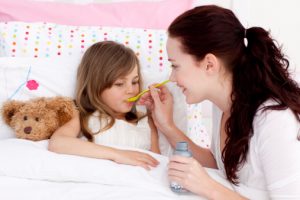 Bronchiolitis – inflammation of the bronchioles – in early childhood has been found to increase the risk of adult asthma. Bronchiolitis is a lung infection commonly experienced by children. It leads to congestion of the small airways (bronchioles) in the lungs.
Bronchiolitis – inflammation of the bronchioles – in early childhood has been found to increase the risk of adult asthma. Bronchiolitis is a lung infection commonly experienced by children. It leads to congestion of the small airways (bronchioles) in the lungs.
Bronchiolitis can occur year-round, but is often worse in the winter months.
Advertisement
Bronchiolitis can begin similar to a cold, but cold-like symptoms can progress to coughing and wheezing and can even make breathing more difficult.
Symptoms of bronchiolitis can last for days, weeks or even months, but with proper care children can get better and will not require hospitalization.
Early childhood bronchiolitis can increase the risk of asthma in adulthood
 Researchers found that children who experience bronchiolitis have a higher risk of developing asthma in adulthood. Bronchiolitis has been linked with asthma, COPD and lung disorders in adulthood. Much of the research that has linked childhood lower respiratory infections has been done in retrospective studies.
Researchers found that children who experience bronchiolitis have a higher risk of developing asthma in adulthood. Bronchiolitis has been linked with asthma, COPD and lung disorders in adulthood. Much of the research that has linked childhood lower respiratory infections has been done in retrospective studies.
For the study, data was collected between 1981 and 1982 from 83 children diagnosed with bronchiolitis – the children were all younger than two years. Forty-eight of the patients were followed up with in 2010 when they were between the ages of 28 and 31. Saint George’s Respiratory Questionnaire (SGRQ) was used to assess quality of life. Participants also underwent medical examinations.
Asthma was diagnosed in 31 percent of those in the bronchiolitis group; lung function was found to be weaker in this group as well.
The findings also revealed that changes in lung function reveal irreversible airway obstruction in those with bronchiolitis, which also signals an increased risk of COPD.
The findings were published in Respiratory Medicine, Pediatric Pulmonology, Acta Paediatrica, and Pediatric Allergy and Immunology.
Bronchiolitis not to be confused with bronchitis
Although bronchiolitis and bronchitis sound the same, they are two different lung illnesses. First off, bronchiolitis is the inflammation of the bronchioles and bronchitis is the inflammation of the bronchi. Bronchioles are smaller airway passages and bronchi are large ones.
In bronchitis inflammation can occur from a slew of factors, including environmental factors, infection or allergies. Bronchiolitis, on the other hand, is more similar to pneumonia, so the cause of bronchiolitis is a mixture of pneumonia and obstructive airway disease.
Related: Is Bronchitis Contagious?
Causes and symptoms of bronchiolitis
Bronchiolitis can be caused by influenza, respiratory syncytial virus (RSV), parainfluenza and other viruses. When bronchiolitis is caused by RSV, wheezing often accompanies the illness.
Symptoms and signs of bronchiolitis include:
 The child widens their nose and squeezes the muscles under the rib cage to release more air
The child widens their nose and squeezes the muscles under the rib cage to release more air- Grunting and tightening stomach muscles may occur when the child breathes
- Wheezing
- Difficulty swallowing or drinking
- If dehydration occurs, the child will have dry mouth, crying without tears, urinating and drinking less often
- Runny nose
- Stuffy nose
- Cough
- Slight fever
Treatment and prevention of bronchiolitis
In order to prevent your child from developing bronchiolitis, follow the below tips.
- Don’t smoke around your child or in areas where your child spends time – smoke can linger in fabrics.
- Wash hands frequently and practice proper hygiene in order to prevent infection.
- Use alcohol-based hand disinfectant.
- Avoid other adults or children that have a respiratory infection.
- Get the annual flu shot.
As for treatment, there are numerous options depending on the severity of bronchiolitis. Treatment for bronchiolitis includes:
- Emergency care should be used if the child is turning blue, vomiting, or tiring out.
- Symptomatic care is a mode of treatment that addresses the symptoms, such as cough medicines or using an inhaler.
- Monitoring the child should be done to ensure symptoms are not worsening.
- Controlling the fever is important.
- Nose drops or nasal sprays can clear congestion.
- Ensure the child drinks plenty of water.
- Keep the child isolated from other children or adults – especially if they are sick.
Related Reading:
COPD and bronchitis patients seek relief from new device
Patients with COPD or chronic bronchitis can obtain relief from their conditions with a new device called Aerobika® made from Trudell Medical International. COPD and chronic bronchitis symptoms can worsen in the winter months, leaving patients breathless. Continue reading…
Advertisement
COPD differences: Emphysema vs. chronic bronchitis
Emphysema and chronic bronchitis are two forms of chronic obstructive pulmonary disease (COPD). Both conditions are life-long and lead to permanent lung complications, which leads to difficulties with breathing. Continue reading…
Sources:
http://www.mayoclinic.org/diseases-conditions/bronchiolitis/basics/symptoms
http://www.sciencedaily.com/releases
http://www.differencebetween.com/difference-between-bronchitis-and-vs-bronchiolitis
https://www.healthychildren.org/English/health-issues/conditions/chest-lungs/Pages/Bronchiolitis
http://www.uptodate.com/contents/bronchiolitis-and-rsv-in-infants-and-children-beyond-the-basics
